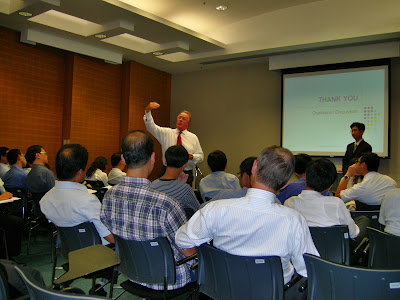In the beginning, Prof. Ng Ka Ming introduced the forum and speakers.

The first speaker was Dr. Peter CHANG (Technical Manager of DuPont China Ltd) and his topic was “Manufacturing and Technology of Silicon Thin Film Solar in DuPont”.

Some key points:
· Why a-Si Solar Cell?
· DuPont Materials for Thin Film PV Modules
· Amorphous-Silicon PV Technology:
1. High absorption coefficient & large bandgap lead to 7-8% efficiency
2. Multi-layer junctions can improve efficiency to 9-12% range
3. Turnkey equipment lines available from multiple vendors
· Process Flow of a-Si Thin Film Solar Cell


The second speaker was Prof. WONG Wai Yeung (Professor of Hong Kong Baptist University) and his topic named “Harvesting Solar Energy using Polymers: Recent Progress and Future Prospects”.
Some key points:
· Why Organic Solar Cell?
1. Low cost
2. Large area
3. Improved coverage of solar spectrum
4. Flexible substrates
· Research on Metallopolymer



The third speaker was Prof. Z.K. TANG (Professor of The Hong Kong University of Science and Technology) and his topic was “基於光合作用原理的全天候生物光電轉換技術”
(I try to translate as “All-weather bio-photoelectronic transfer technology based on photosynthesis principle”.)
Some key points:
By using photosynthesis of Blue-Green Algae, self-sustainable all-weather solar cell could be developed. The fuels of this cell are water and carbon dioxide in air.




Then, Speaker Dr. Steve CHEN (Corporate Strategist of China Solar Energy Holdings Ltd.) presented the topic of “The Emerging Thin Film PV Industry and CSE's Strategic Development in the Market”.
Some key points:
· Existing problems
1. High initial cost
2. Lack feasible regulations and policies
3. Need proper financial incentives
4. Lack technical standards and certification
My colleague Mr. Stephen IP (Manager of Optoelectronic and Nanotechnology from Hong Kong Science & Technology Parks) presented the topic of“Hong Kong – Emerging Base of Photovoltaic & Clean Technology for China”.
Some key points:
DuPont planned to build a new R&D facility in Hong Kong as well as a production facility in Shenzhen, China for current and future materials used for traditional crystalline silicon (c-Si) cell and module markets. The company would also expand into serving the fast-growing amorphous silicon (a-Si) thin-film market.
(I try to translate as “All-weather bio-photoelectronic transfer technology based on photosynthesis principle”.)
Some key points:
By using photosynthesis of Blue-Green Algae, self-sustainable all-weather solar cell could be developed. The fuels of this cell are water and carbon dioxide in air.




Then, Speaker Dr. Steve CHEN (Corporate Strategist of China Solar Energy Holdings Ltd.) presented the topic of “The Emerging Thin Film PV Industry and CSE's Strategic Development in the Market”.
Some key points:
· Existing problems
1. High initial cost
2. Lack feasible regulations and policies
3. Need proper financial incentives
4. Lack technical standards and certification
My colleague Mr. Stephen IP (Manager of Optoelectronic and Nanotechnology from Hong Kong Science & Technology Parks) presented the topic of“Hong Kong – Emerging Base of Photovoltaic & Clean Technology for China”.
Some key points:
DuPont planned to build a new R&D facility in Hong Kong as well as a production facility in Shenzhen, China for current and future materials used for traditional crystalline silicon (c-Si) cell and module markets. The company would also expand into serving the fast-growing amorphous silicon (a-Si) thin-film market.
















